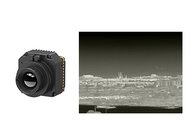-
Thermal Camera Core
-
Thermal Security Camera
-
Drone Thermal Camera
-
EO IR Systems
-
Thermal Imaging Binoculars
-
Infrared Thermal Camera Module
-
High Resolution Thermal Camera Module
-
Cooled Infrared Detectors
-
Optical Gas Imaging
-
Thermal Camera For Fever Detection
-
Cooled Camera Modules
-
Vehicle Mounted Thermal Camera
-
Integrated Dewar Cooler Assembly
-
Uncooled Infrared Detectors
Uncooled LWIR Thermal Camera Core 400x300 17μM for Building Inspection

Contact me for free samples and coupons.
Whatsapp:0086 18588475571
Wechat: 0086 18588475571
Skype: sales10@aixton.com
If you have any concern, we provide 24-hour online help.
x| Resolution | 400x300 / 17μm | Frame Rate | 25Hz/30Hz/50Hz/60Hz |
|---|---|---|---|
| NETD | <30mK | Spectral Range | 8~14μm |
| Size | 44.5x44.5x33.6mm | Weight | ≤77g |
| Highlight | LWIR Thermal Camera Core 17uM,Building Inspection LWIR Camera Core |
||
400x300 17μM LWIR Thermal Camera Module Uncooled With Industrial Thermography
PLUG417R thermal camera core uses the 400x300 / 17μm uncooled LWIR infrared detctor with an optional temperature measurement function with measurement range from -20℃~150 ℃ for industrial or body temperature measurement. This infrared thermal module can not only measures the value of temperature around you but also display the thermal imaging figure. So it must be your best choice to monitor the temperature change.
This small infrared camera module can be widely used in infrared thermal imaging applications such as Thermography, Electricity Power Inspection, Building Inspection etc. It is beneficial to OEM customers for secondary development and integration in all kinds of thermal imagers and infrared thermographic cameras.
- NETD<30mk, High Sensitivity
- Stable Performance
- Easy Integration
- Clear Image Quality & Details
- Customizable Temperature Range
- Strong Environmental Adaptability
| Model | PLUG417R |
| IR Detector Performance | |
| Resolution | 400x300 |
| Pixel Pitch | 17μm |
| Spectral Range | 8~14μm |
| NETD | <30mk |
| Image Processing | |
| Frame Rate | 25Hz/30Hz/50Hz/60Hz |
| Start-up Time | <15s |
| Analog Video | PAL/NTSC |
| Digital Video | RAW/YUV/BT656/LVDS |
| Extension Component | USB/Camerlink |
| Dimming Mode | Linear/Histogram/Mixed |
| Digital Zoom | 1~8X Continual Zoom, Step Size 1/8 |
| Image Display | Black Hot/White Hot/Pseudo Color |
| Image Direction | Horizontally/Vertically/Diagonally Flip |
| Image Algorithm | NUC/AGC/IDE |
| Electrical Specification | |
| Standard External Interface | 50pin_HRS Interface |
| Communication Mode | RS232-TTL, 115200bps |
| Supply Voltage | 4.5~6V |
| Temperature Measurement | |
| Operating Temperature Range | -10°C~50°C |
| Temperature Range | -20°C~150°C, 100°C~550°C |
| Temperature Accuracy | ±2°C or ±2% (Take the Maximum Value) |
| SDK | ARM/Windows/Linux SDK, Full Screen Thermography |
| Physical Characteristics | |
| Dimension (mm) | 44.5x44.5x36.6 |
| Weight | ≤77g |
| Environmental Adaptation | |
| Operation Temperature | -40°C ~ +70°C |
| Storage Temperature | -45°C ~ +85°C |
| Humidity | 5%~95%, Non-condensing |
| Vibration | Random Vibration 5.35grms, 3 Axis |
| Shock | Half-sine Wave, 40g/11ms, 3 Axis 6 Direction |
| Optics | |
| Optional Lens | Fixed Focus Athermal: 7.5mm/13mm/19mm/25mm/35mm |
The PLUG417R thermal camera core is widely used in Electric Power Inspection, Machine Vision, Building HVAC Security & Monitoring, Outdoors, Firefighting & Rescue, Law Enforcement & Rescue, ADAS, UAV Payloads etc.
![]()
![]()
1. What is Infrared Detector Resolution
That is, the number of pixels of thermal imaging. The higher resolution means more observation and temperature measurement points, thus smaller target at longer distance can be observed and measured. Usually the resolution of infrared thermal imaging ranges from 256x192, 384x288, 640x512, 800x600, 1024x768, 1280x1024, etc. With higher resolution, the cost of detector will be more.
2. Field of View (FOV)
It refers to the two-dimensional field of view of the object space observed by the optical system of infrared thermal imager. Taking the horizontal FOV as an example, assuming that the detector array size is A×B, the pixel size is d, and the lens focal length is f, then the horizontal FOV angle θ=2×acrtan (A×d/2f).
After the detector array and pixel size are selected, the field of view only changes with the focal length of the optical system: with longer focal length, the field of view will be narrower; with shorter focal length, the field of view will be wider.




